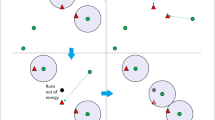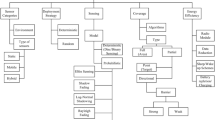Abstract
Coverage is a fundamental problem in sensor networks. Sensor coverage, which reflects how well a sensor network is monitored by sensors, is an important measure for the quality of service (QoS) that a sensor network can provide. In mobile sensor networks, the mobility of sensor nodes can be utilized to enhance the coverage of the network. Since the movement of sensor nodes will consume much energy, this mobility of sensor nodes should be properly managed by some pre-defined schemes or protocols. By noticing this issue, some existing works have proposed several movement-assisted sensor deployment schemes. These works assume that the target field is a 2-dimensional space. In this paper, we study a generalized case of this problem whereby the target field can be a space which ranges from 1-dimensional to 3-dimensional. Two variations of the movement-assisted sensor deployment problem with different optimization objectives were formulated. We identify a set of basic attributes which can be used as guidelines for designing movement-assisted sensor deployment schemes. Based on these attributes, we propose efficient algorithms for both variants of the movement-assisted sensor deployment problem.










Similar content being viewed by others
References
Cayirci E, Tezcan H, Dogan Y, Coskun V (2006) Wireless sensor networks for underwater surveillance systems. Ad Hoc Networks 4(4):431–446
Chakrabarty K, Iyengar SS, Qi H, Cho E (2001) Coding theory framework for target location in distributed sensor networks. In: Proceedings of international symposium on information technology: coding and computing, vol 1, pp 130–134
Chakrabarty K, Iyengar SS, Qi H, Cho E (2002) Grid coverage for surveillance and target location in distributed sensor networks. IEEE Trans Comput 51:1448–1453
Chang RS, Wang SH (2008) Self-deployment by density control in sensor networks. IEEE Trans Veh Technol 57(3):1745–1755
Chellappan S, Gu W, Bai XL, Xuan D, Ma B, Zhang K (2008) Deploying wireless sensor networks under limited mobility constraints. IEEE Trans Mob Comput 6(10):1142–1157
de Berg M, van Kreveld M, Overmars M, Schwarzkopf O (2004) Computational geometry: algorithms and applications. ACM Trans Embed Comput Syst (TECS) 3(1):61–69
Hadim S, Mohamed N (2006) Middleware: middleware challenges and approaches for wireless sensor networks. IEEE Distrib Syst Online 7(3):1–23
Haenselmann T (2006) An FDL’ed textbook on sensor networks. www.informatik.uni-mannheim.de, vol v1, no v1
Heidemann J, Wei Y, Wills J, Syed A, Yuan L (2006) Research challenges and applications for underwater sensor networking. In: Proceedings of IEEE wireless communications and networking conference, pp 228–235
Heo N, Varshney PK (2005) Energy-efficient deployment of intelligent mobile sensor networks. IEEE Trans Syst Man Cybern 35(1):78–92
Howard A, Mataric MJ, Sukhatme GS (2002) An incremental deployment algorithm for mobile robot teams. In: Proceedings of IEEE/RSJ international conference on intelligent robots and system, vol 3, pp 2849–2854
Huang CF, Tseng YC (2004) The coverage problem in a wireless sensor network. ACM Mob Netw Appl 10(4):519–528
Huang CF, Tseng YC, Lo LC (2007) The coverage problem in three-dimensional wireless sensor networks. J Interconnect Netw 8(3):209–227
Khatib O (2006) Real-time obstacle avoidance for manipulators and mobile robots. Int J Rob Res 5(1):90–98
Lee J, Dharne DA, Jayasuriya S (2007) Potential field based hierarchical structure for mobile sensor network deployment. In: Proceedings of American control conference, vol 1, pp 5946–5951
Mehta DP, Lopez MA, Lin L (2003) Optimal coverage paths in ad-hoc sensor networks. In: Proceedings of IEEE international conference on communications, vol 1, pp 507–511
O’Rourke J (1998) Computational geometry in C, vol v2, no v2. Cambridge University Press, New York
Popa DO, Stephanou HE, Helm C, Sanderson AC (2004) Robotic deployment of sensor networks using potential fields. In: Proceedings of IEEE international conference on robotics and automation, vol 1, pp 642–647
Romer K, Mattern F (2004) The design space of wireless sensor networks. IEEE Wirel Commun 11 (6):54–61
Sundhar Ram S, Manjunath D, Lyer SK, Yogeshwaran D (2007) On the path coverage properties of random sensor networks. IEEE Trans Mob Comput 6(5):446–458
Wang G, Cao G, La Porta T (2003) A bidding protocol for deploying mobile sensors. In: Proceedings of the 11th IEEE international conference on network protocols (ICNP), pp 315–324
Wang G, Irwin MJ, Berman P, Fu H, La Porta T (2005) Optimizing sensor movement planning for energy efficiency. In: Proceedings of the 2005 international symposium on low power electronics and design, pp 215–220
Wang G, Cao G, La Porta T, Zhang W (2005) Sensor relocation in mobile sensor networks. In: Proceedings of INFOCOM, vol 4, pp 2302–2312
Wang G, Cao G, La Porta T (2006) Movement-assisted sensor deployment. IEEE Trans Mob Comput 5(6):640–652
Watfa MK, Commuri S (2006) A coverage algorithm in 3D wireless sensor networks. In: Proceedings of the 1st international symposium on wireless pervasive computing
Watfa MK, Commuri S (2006) An energy efficient 3-dimensional wireless sensor cover. In: Proceedings of The 3rd IEEE consumer communications and networking conference, pp 959–963
Watfa MK, Commuri S (2006) Optimality measures for coverage in 3D wireless sensor networks. In: Proceedings of the 1st international symposium on wireless pervasive computing
Watfa MK, Commuri S (2006) Optimal 3-dimensional sensor deployment strategy. In: Proceedings of The 3rd IEEE consumer communications and networking conference, pp 892–896
Watfa MK, Commuri S (2006) The 3-dimensional wireless sensor network coverage problem. In: Proceedings of the IEEE international conference on networking, sensing and control, pp 856–861
Yang S, Li M, Wu J (2007) Scan-based movement-assisted sensor deployment methods in wireless sensor networks. IEEE Trans Parallel Distrib Syst 18(8):1108–1121
Zou Y, Chakrabarty K (2004) Sensor deployment and target localization in distributed sensor networks. ACM Trans Embed Comput Syst (TECS) 3(1):61–69
Author information
Authors and Affiliations
Corresponding authors
Rights and permissions
About this article
Cite this article
Fang, C., Zhang, P., Fu, C. et al. Coverage enhancement by using the mobility of mobile sensor nodes. Multimed Tools Appl 69, 819–842 (2014). https://doi.org/10.1007/s11042-012-1139-4
Published:
Issue Date:
DOI: https://doi.org/10.1007/s11042-012-1139-4




